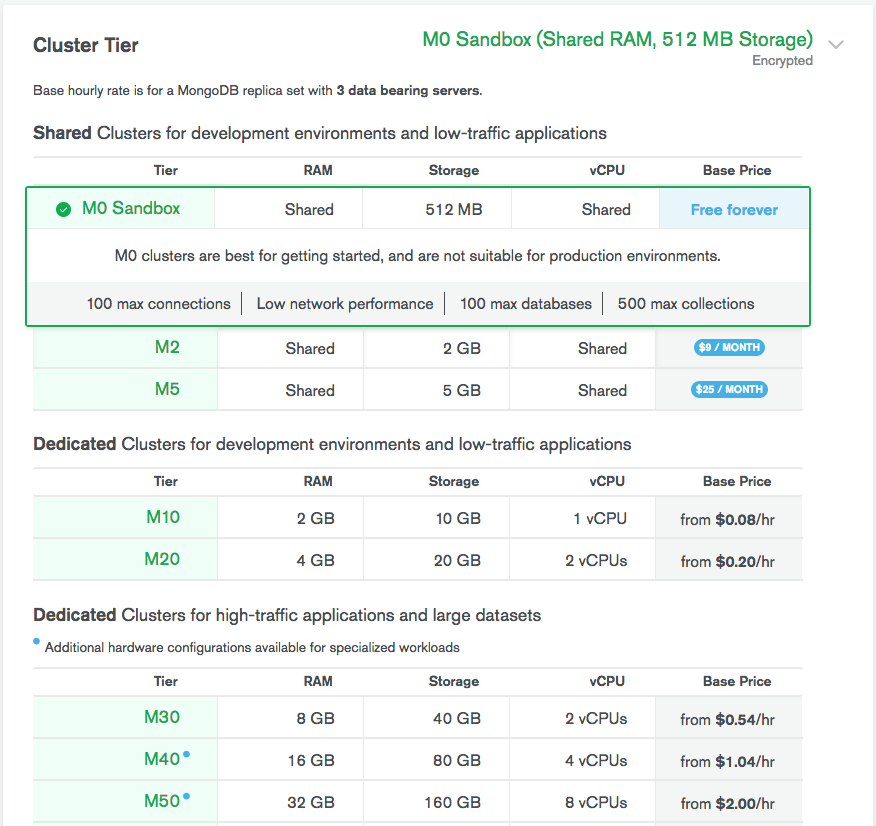Cluster Tier¶
On this page
The cluster tier dictates the memory, storage, and IOPS specification for each data-bearing server [1] in the cluster.

You might see different values depending on your selected cloud provider and region.
Shared Clusters¶
Shared clusters are economical clusters for getting started with MongoDB and for low-throughput applications. These clusters deploy to a shared environment with access to a subset of Atlas features and functionality. For complete documentation on shared cluster limits and restrictions, see Atlas M0 (Free Cluster), M2, and M5 Limitations.
M0 clusters are free sandbox replica set clusters. You can deploy
one M0 cluster per Atlas project. You can
upgrade an M0 free cluster to an
M2+ shared cluster at any time.
M2 and M5 clusters are low-cost shared clusters.
These clusters provide the following additional features and
functionality compared to M0 clusters:
- Backups for your cluster data
- Increased storage
- API access
Considerations¶
- Atlas deploys MongoDB 4.4 for all
Shared Clusters (
M0,M2, andM5). However, Shared Clusters do not support all functionality in MongoDB version 4.4 and later. See Atlas M0 (Free Cluster), M2, and M5 Limitations for details. Atlas supports shared cluster deployment in a subset of Cloud Providers and Regions. Atlas greys out any shared cluster tiers not supported by the selected cloud service provider and region. For a complete list of regions that support shared cluster deployments, see:
Dedicated Clusters for Low-Traffic Applications¶
M10 and M20 cluster tiers support development environments and low-traffic
applications.
These clusters support replica set deployments only, but otherwise provide full access to Atlas features and functionality.
M10 and M20 cluster tiers run on
burstable performance infrastructure.
Dedicated Clusters for High-Traffic Applications¶
M30 and higher cluster tiers support production environments with
high traffic applications and large datasets.
These clusters support replica set and sharded cluster deployments with full access to Atlas features and functionality.
Some clusters have variants, denoted by the ❯ character. When you select these clusters, Atlas lists the variants and tags each cluster to distinguish their key characteristics.
NVMe Storage on AWS Clusters¶
For applications hosted on AWS which require low-latency and high-throughput I/O, Atlas offers storage options using locally attached ephemeral NVMe SSDs. The following cluster tiers have an NVMe option, with the size fixed at the cluster tier:
M40M50M60M80M200M400
Clusters with NVMe storage use Cloud Backups for backup. You can't disable backup on NVMe clusters. If you want to use hourly backups, Atlas limits backups on NVMe clusters to once every 12 hours.
NVMe clusters use a hidden secondary node consisting of a provisioned volume with high throughput and IOPS to facilitate backup.
You can't pause an NVMe cluster.
NVMe clusters auto-scale to the next higher tier when 90% of the available storage space is consumed, and the migration requires an initial sync.
Free, Shared, and Dedicated Cluster Comparison¶
The following table highlights key differences between an M0 Free
Tier cluster, an M2 or M5 shared cluster, and an
M10+ dedicated cluster.
Free Cluster ( M0) | Shared Cluster ( M2 and M5) | Dedicated Cluster ( M10 and larger) | |
|---|---|---|---|
Storage (Data Size + Index Size) | 512 MB | M2: 2 GBM5: 5 GB | 10 - 4000 GB |
MongoDB Version Support | 4.4 | 4.4 | 4.0, 4.2, 4.4 |
Metrics and Alerts | Limited | Limited | Full metrics, including the
Real Time Performance Tab,
and full alert configuration options. |
VPC Peering | No | No | |
Global Region Selection | Atlas supports deploying M0 clusters in a subset of
regions in AWS, Google Cloud, and Azure. | Atlas supports deploying M2 and M5 clusters in a
subset of regions in AWS, Google Cloud, and Azure. | Atlas supports deploying clusters globally on
Amazon Web Services,
Google Cloud Platform, and
Microsoft Azure |
Cross-Region Deployments | No | No | |
Backups | No | Yes, including queryable backups | |
Sharding | No | No | Yes, for clusters using an M30+ tier |
Dedicated Cluster | No, M0 free clusters run in a shared environment | No, M2 and M5 clusters run in a shared environment | Yes, M10+ clusters deploy each mongod process to
its own instance. |
Performance Advisor | No | No | Yes |
BI Connector for Atlas | No | No | Yes |
For a complete list of M0 free cluster, M2, and M5 limitations, see Atlas M0 (Free Cluster), M2, and M5 Limitations.
| [1] | For replica sets, the data-bearing servers are the servers hosting the replica set nodes. For sharded clusters, the data-bearing servers are the servers hosting the shards. For sharded clusters, Atlas also deploys servers for the config servers; these are charged at a rate separate from the cluster costs. |